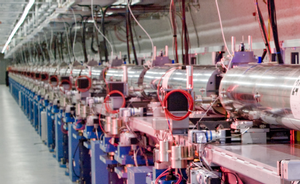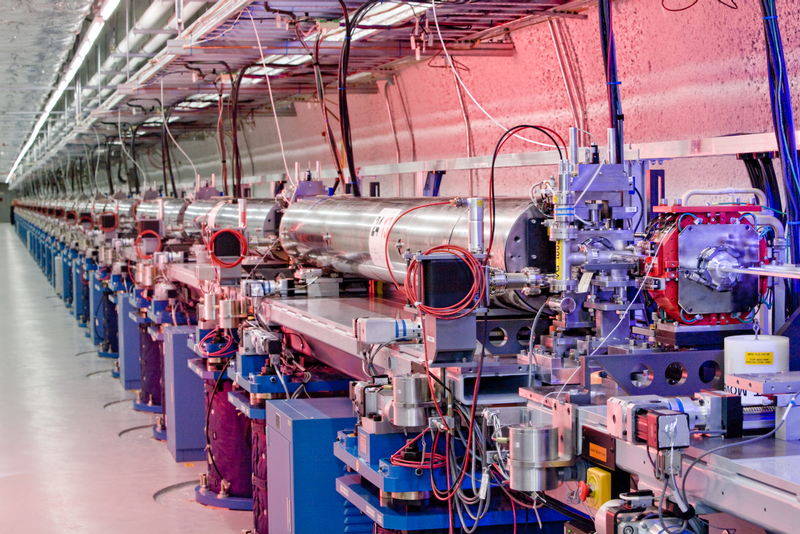Storing an X-ray Photon
In the field of photonics, researchers dream of performing all manner of electronics operations with photons instead of electrons, but so far they have only used visible and infrared light. Building on an earlier experiment that showed how x rays could be briefly stored in nuclear excitations, a team writing in Physical Review Letters now proposes a technique that would store a single x-ray photon and allow it to be released on demand with its quantum properties unchanged. The work is a first step toward x-ray photonic systems, which could exploit the shorter wavelengths of x rays to pack more active elements into a given space.
In 1996, a team led by Yuri Shvyd’ko, then at the University of Hamburg, Germany, succeeded in delaying the decay of an excited nuclear state of iron-57 with an energy of 14.4 kilo-electron-volts (keV) [1]. The team fired a short pulse from a polarized beam of 14.4-keV x rays at an iron-57 target in the presence of a magnetic field perpendicular to the beam. The field splits the nuclear ground state into two levels with slightly different energies and splits the excited state into four levels. The geometry of the experiment allowed a transition from each ground state only to a specific upper state, so that just two of the four excited levels were populated. The resulting nuclear excitation was a quantum combination (superposition) of these two states, and because of their different magnetic properties, it turns out that the probability for the nucleus to decay back to the ground state oscillates in time.
A few nanoseconds after the excitation, the team turned on a second magnetic field, perpendicular to the first. By changing the orientation of the magnetic field, this second field, in effect, mixed up the identity of the upper states, so that the excitation was spread among all four of them. Shvyd’ko and his colleagues showed that this procedure, when done at the right time in the oscillation cycle of the excitation, transformed it into a state that could not easily decay. Turning off the second field allowed the nucleus to decay and emit an x-ray photon.
In this experiment, the photons that emerged after being “stored” had the same energy as the original photons, but other quantum properties were not preserved. To overcome that deficiency, and to allow single-photon manipulation, Adriana Pálffy and her colleagues at the Max Planck Institute for Nuclear Physics in Heidelberg, Germany, suggest a variation on the technique. As before, they use polarized x-ray photons to excite iron-57 nuclei immersed in a magnetic field. By adjusting the intensity of the beam and the concentration of iron-57 atoms, it can be arranged that most of the time, just a single nuclear excitation will be created by the x-ray pulse.
Instead of adding a second field, the team proposes turning off the first altogether at a specific moment in the oscillation of the excited state, about 10 nanoseconds after the x-ray pulse. The team’s calculations show that the excitation would then be “frozen” in a quantum state that does not allow decay by the usual route. Reapplying the magnetic field after an arbitrary time would allow the excitation to decay and emit a photon identical in all of its quantum properties—energy, polarization, and phase—to the photon that created the excitation. It should be possible to store an x-ray photon for 100 nanoseconds or more with its full quantum properties intact, according to Pálffy.
The new proposal also offers a bonus: if the magnetic field is reapplied with opposite polarity, the phase of the emitted photon is exactly reversed. Although this is a modest capability compared to what can be done with visible photons, Pálffy and her colleagues argue that their proposed technique is a first step toward photonics systems operating at much shorter wavelengths.
Gennady Smirnov of the Kurchatov Institute in Moscow says that the proposed storage method certainly preserves polarization and phase, but he has some doubts about its practicality, particularly in the need to switch a magnetic field off and on so quickly. But Norman Sherman, of the National Research Council of Canada in Ottawa, says the proposed method “opens the door to coherent quantum optics for x rays,” which might be used for future quantum computers.
–David Lindley
David Lindley is a freelance science writer in Alexandria, Virginia.
References
- Yu. V. Shyvd’ko et al., “Storage of Nuclear Excitation Energy Through Magnetic Switching,” Phys. Rev. Lett. 77, 3232 (1996)





